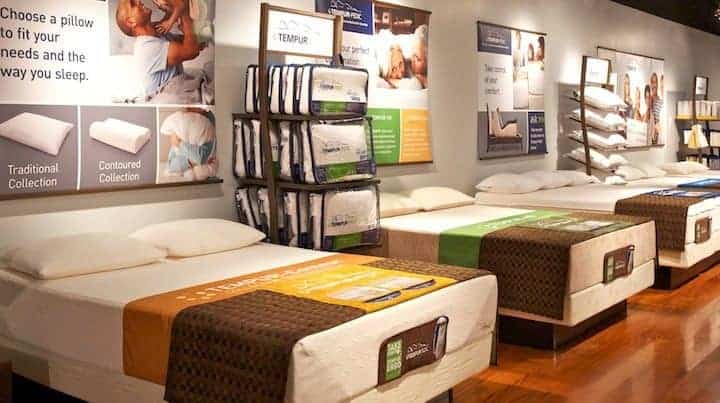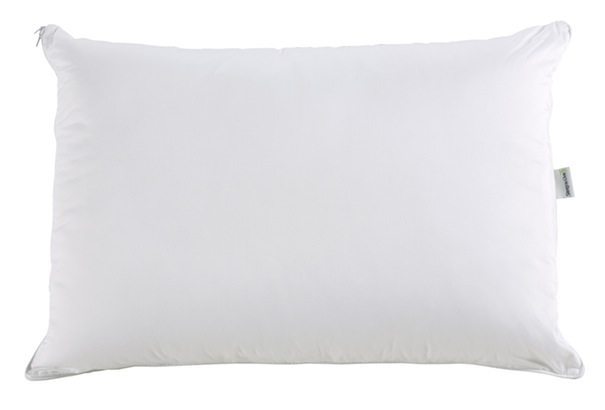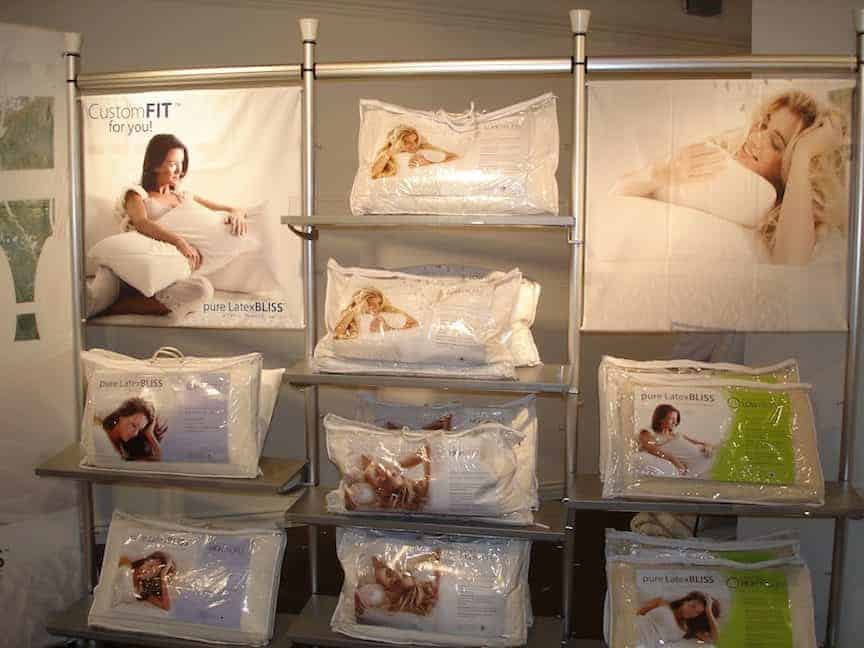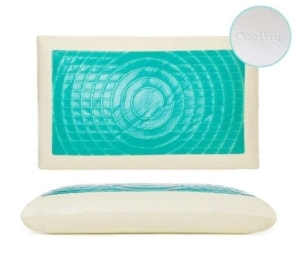
Today’s producers are offering a wide range of options to consumers, from basic fiber and shredded foam models at the lower end to sophisticated latex, memory foam, down-fill, gel and even innerspring and air models at the medium to higher ends. Price points start as low as $9.95 retail at big-box chains and run up to $300 and more for premium constructions.
No longer an afterthought, pillows are being inserted into retail sales associates’ mattress sales conversations right from the start as a key component of any sleep system. And with their strong potential to generate both additional traffic and sales, pillows are drawing more attention from sleep products manufacturers seeking to deepen their presence on retail floors and bolster their bottom lines.
Competition stirs advances

Pillows play a prominent role in Lexington, Ky.-based Tempur-Pedic’s sales presentation at retail, with colorful posters and display racks providing information and guidance to consumers.
“The pillow segment has grown much more competitive lately, but competition and innovation are a good thing,” says Dan Setlak, vice president of marketing for Tempur-Pedic in Lexington, Ky. “It results in more options for consumers and raises the bar on the category from a quality and feature standpoint.”
A longtime major in the category, Tempur-Pedic segments its pillow offerings into two collections: Filled, which combines the pressure-relieving comfort of its Tempur material with a traditional pillow shape; and Contoured, also with Tempur material, but with ergonomically contoured shapes that help align the head, neck and shoulders.
Retail prices in the company’s pillow line start at $79 and top out at $399 for a king-size version of the GrandPillow, with enhanced Tempur-HD material and an ultra-luxurious cover. The bulk of sales falls in the $129 to $149 range.
Seeing those sorts of price tags can be a shock to some consumers, Setlak acknowledges.
“But once they try our pillows, they recognize the value,” he says. “We offer the only sleep products with patented Tempur technology—a demonstrable difference that you feel when you pick up and squeeze the pillow. It’s huggable, shapeable support.”
For many consumers, buying a Tempur-Pedic pillow is the start of a longtime relationship with the company.
“They come in seeking a better night’s sleep and buy a pillow or two to see if that will help,” Setlak says. “Once they see the results, they often decide to replace their mattress with one of our sets.”
Going forward, Tempur-Pedic will continue to invest in new product development to keep its pillow line innovative, Setlak says. Most recently, the company carried out some “aesthetic refreshes” to its pillow covers and styling to keep products current.
Setlak says the company projects continued growth for the category this year.
Responding to the sleeper

Introduced in September, Carpenter Co.’s ErgoSmart uses foam nodules that shift in four directions to provide free movement of the head and neck with no reduction in support. The pillow, shown here in a traditional style, results in fewer unnatural awakenings, according to the Richmond, Va.-based producer.
At Carpenter Co., an industry supplier of foams and fibers based in Richmond, Va., pillows fall into two distinct segments, both of which are experiencing solid growth, says Dan Schecter, senior vice president of sales and marketing. The first segment—the “commodity” part of the business—consists of polyester-filled pillows retail priced from $4.99 to $12.99. They’re sold through mass merchants and other discount chains.
The second segment is the “value-added line,” which features technology-driven fibers and fabrics designed to enhance sleep. Priced from $19.99 to $129 at retail, these pillows include Ambient Comfort, part of Carpenter’s Signature collection, which uses the microtechnology of Celliant fiber to enhance the level of oxygen in the body by as much as 29%, reducing pain and relieving muscle stress. The Beyond Down pillow is filled with superfine gel fiber that emulates the highest-quality European white goose down. Isotonic is made of 100% Isotonic memory foam, which helps relieve pressure and alleviate tossing and turning in bed, and Iso-Cool features Outlast Adaptive Comfort material that self-adjusts to the body’s changing temperature.
Carpenter’s newest collection is ErgoSmart, introduced in September. ErgoSmart is made of a visco-elastic foam with a quick-recovery formula. The pillow’s design provides free movement for the head and neck with no reduction in support, which reduces unnatural awakenings, according to the company.
“With a cheap polyester pillow, the only movement is two-dimensional—they go up or down,” Schecter says. “But that’s not the way we sleep. Most of us are very active, moving up and down, left to right, and sideways. With ErgoSmart, we offer a more dynamic, four-dimensional feel with support and comfort that’s more in tune with the sleeper’s movement—similar to the independent suspension in a car. It means no more waking up to fluff your pillow or shove it under your head so you don’t get a stiff neck.”
As with mattresses, it’s important for RSAs to help consumers identify their sleeping patterns, as well as their comfort and support needs so that they choose the right pillow, Schecter says.
For 2013, Carpenter will continue to bring out new pillows that reflect ongoing advances in chemicals, fills and fabrics.
“We typically bring out 60 new sleep products every six months,” Schecter says. “Our goal is to stay at the leading end of sleep technology.”

Soff-Art’s patented Wonderpillow contains the company’s proprietary Morpheus Spring System—a fine-gauge 3.5-inch tall innerspring unit—wrapped in a layer of visco-elastic foam. The company is based in Terni, Italy.
Coils plus visco
Another pillow producer moving its line forward through innovation is Soff-Art, based in Terni, Italy. The company, which specializes in pillows with innersprings at their core, introduced the Viscospring Wonderpillow in a number of global markets. The pillow contains the company’s proprietary Morpheus Spring System—a fine-gauge 3.5-inch tall innerspring unit—wrapped in a layer of visco-elastic foam for additional support and comfort.
The patented Viscospring Wonderpillow has better airflow and more head and neck support than traditional pillows, the company says. It also is dust mite and allergen-proof.
“The pocketed coils balance head weight and movement, while the visco-elastic foam shapes itself to match the sleeper’s exact profile,” says Maurizio Momoli, sales and marketing manager.
“The coils and memory foam resume their form when not in use, providing lasting performance.”
Soff-Art sells the Viscospring Wonderpillow in Europe, Asia and South America and is looking for a manufacturing partner to handle U.S. sales, similar to how it markets other Morpheus products.
After several quiet years due to the recession, Soff-Art has seen “an upward trend” in U.S. sales recently.
“Business conditions remain very tough, but our segment, which is positioned more toward the luxury end, has been doing better than others,” Momoli says. “Consumers are willing to pay more for quality sleep and products than can help them achieve it.”
Momoli adds that the Morpheus line’s pocketed spring core sets it apart from other pillows in the marketplace, providing independent movement that makes the pillows comfortable in any position. The current range of Morpheus pillows retails for $50 to $75 in the United States.
“When we do training, we explain that it’s important for the RSA to explain that when a shopper is spending $50 or $75 on a pillow, they’re investing in their health,” Momoli says. “Instead of buying dinner or a nice shirt, why not spend a little more toward wellness and quality of life?”
Despite continuing economic challenges in the United States, Soff-Art is optimistic that 2013 will be a good growth year.
“Pillows are no longer being relegated to the back of the store as a mere accessory to the bed,” Momoli says. “Successful retailers are merchandising pillows as an integral part of sleep and showing consumers that if their pillows are not compatible with their mattresses, they’re not going to have a good sleep experience.”

Mebane, N.C.-based Kingsdown uses its bedMATCH sleep diagnostic system to assist consumers in determining the best mattress and pillow options for their body types. One pillow that’s sold well for Kingsdown is FiberTouch, an alternative to goosedown that is durable, machine washable and anti-microbial.
Creating the right match
Mebane, N.C.-based mattress manufacturer Kingsdown offers a pillow collection that was designed in tandem with its bedMATCH sleep diagnostic system. The culmination of more than 15 years of research and development and 6 million consumer profiles, the bedMATCH system uses 18 measurements and more than 1,000 calculations to assist consumers in determining the best mattress and pillow options for their body types.
“BedMATCH—or in this case, pillowMATCH—is the most intelligent way to choose a pillow using the latest technology and information from sleep research,” says Frank Hood, president and chief executive officer. “Shoppers answer some basic questions at an in-store kiosk, and the diagnostic system recommends potential pillows to be tested. It is a fun experience that marries sleep with science to find the best bed and pillow option needed to enjoy a sound sleep.”
Kingsdown originally entered the pillow category because “it made sense for us to include pillows as part of a sleep system and offer retailers and consumers a full lineup of product,” Hood says. The company’s pillow line includes down, foam, latex and polyfill in a range of standard sizes.
According to Hood, experienced RSAs are helping to drive the growth of the pillow category.
“They know that in addition to being a great way to increase the sale ticket, consumers need an entire sleep system to help them get a good night’s sleep.”
At the same time, today’s consumers are better educated about the role that quality bedding plays in sleep.
“More people understand that there is a benefit difference between a $20 pillow and a $100 one,” Hood says. “Pillows designed for different sleep styles—back, side and stomach—are gaining popularity as more consumers realize that just like mattresses, one size does not fit all.”
Advancing the category

Pillows are a ‘very important category’ for Atlanta-based Pure LatexBLISS, says company President Kurt Ling. This display, photographed at the summer Las Vegas Market, will be augmented in January with a new pillow line featuring bio-rubber latex derived from the guayule plant.
A recent introduction to the Pure LatexBLISS pillow line incorporates ActiveFUSION climate-control technology, which features patented phase-change materials that are fused inside the Talalay latex and woven into the yarns of the cover fabric. The exclusive formulation moderates heat energy released from the body “to cool down a warm sleeper and warm up a cool sleeper,” says Kurt Ling, president of the mattress producer, which has headquarters in Atlanta.
In addition to the ActiveFUSION collection, Pure LatexBLISS’ line includes a range of Classic Talalay and All Natural Talalay pillows, as well as LatexDOWN and C4 Contour pillows priced from $99 to $199 retail.
At the winter Las Vegas Market Jan. 28-Feb. 1 at the World Market Center, the company will launch a line featuring bio-rubber latex derived from the guayule plant, a renewable, nonfood crop. Produced by Yulex Corp., the new bio-rubber latex offers an option to Pure LatexBLISS’ other latex products derived from Hevea rubber trees.
“This is a ‘new to the world’ latex technology that has never been used before in our category,” Ling says. “Not only does Yulex produce a high-performance bio-rubber, we were excited to learn that it is derived from a plant grown in the United States.” The new line will include mattresses, toppers and pillows.
Pillows continue to be a “very important category” for Pure LatexBLISS.
“2012 was a growth year and we expect 2013 will be even better,” Ling says.
According to Ling, a growing number of retailers no longer treat the category as an add-on to be presented only at the end of a sale—if at all.
“Retailers who are successful with the category realize that pillows are a big part of any sleep system,” he says. “They’re encouraging salespeople to bring up the pillow early in the sales discussion so that consumers are aware of their options.”
Another reason to bring up pillows during any sleep sale is the fact that the consumer’s current pillows—no matter how new—may not be a good fit for the new mattress’ performance properties.
“We recommend that salespeople encourage consumers to match their pillows to their mattresses so that they are compatible and not working against each other,” Ling says. “It doesn’t make sense to make a significant investment in a mattress and then sleep with a pillow that you’ve had for five years.”
The nature of Talalay latex enables Pure LatexBLISS to tailor its products to a range of size and firmness preferences, Ling adds. For example, its new ActiveFUSION climate-control pillows can be constructed so that one side is fast response and the other is slow, offering sleepers two different comfort options.

Blue Chill, a recent addition to St. Louis-based Glideaway’s Sleepharmony pillow line, combines the temperature-regulating benefits of a gel layer with the comfort and support of memory foam.
Gel generating growth
St. Louis-based bed frame and mattress producer Glideaway, which expanded its sleep products line into pillows four or five years ago, saw pillow sales jump 25% in 2012. Leading the growth was the company’s new Blue Chill line of gel memory foam pillows. Introduced at the summer Las Vegas Market, Blue Chill has been “a big hit” with the company’s base of top 100 retailers and sleep specialists, says Dan Baker, vice president of sales for North America.
“Gel is a hot topic in the industry right now, and with our wholesale price of $32.95, retailers have a product with all the whistles that consumers want that they can sell for anywhere from $59 to $79, generating a very healthy margin,” he says.
Also doing well for Glideaway is All Seasons, an advanced memory foam pillow with a custom, two-sided cover. One side uses thermo-regulation fabric to deliver cool comfort; the other side sports an ultra-plush surface that provides comforting warmth. The All Seasons pillow is priced at $69 retail.
In addition to memory foam, Glideaway offers two lines of fiber and latex pillows under the Sleepharmony brand. In 2013, the company plans to enhance all of its lines by introducing covers that wick away moisture and offer temperature- and allergen-control properties.
The company projects pillow sales to rise another 25% in 2013, led by the continued rollout of the Blue Chill model.
“This should be a very good year for us,” Baker says. “Because of limited supplies, we were able to place Blue Chill with only 15% to 20% of our retailers. So we see a huge opportunity for growth in gel pillows.”
Baker expects good growth in other segments of the Glideaway pillow line, as well.
“Retailers are paying more attention to the pillow category,” he says. “They’re regarding it as an important complement to their mattress business and a profit center in its own right, not just a promotional giveaway.”
Consumers also are growing more open to the idea of investing in better pillows.
“At least a quarter of the sleep experience depends on having a good pillow,” Baker says. “And having the right alignment of the neck while you sleep is as important as having the right support for your back. Today’s consumers are better educated about the benefits of various sleep surfaces, and they recognize the role a pillow can play in quality sleep. The two products go hand in hand.”
What’s the pillow replacement cycle?
When it comes to how often consumers should replace their pillows, the industry consensus seems to be every two or three years—if not sooner.
But, except for lower-end models, the decision depends more on hygiene considerations than on performance, because most quality pillows will last for several years without breaking down, producers agree.
“Our studies show that, on average, consumers will change out their primary pillow every two or three years,” says Dan Setlak, vice president of marketing for Tempur-Pedic in Lexington, Ky. “But they don’t generally throw it away. They’ll relegate it to ‘second’ or ‘third pillow’ status, using it when they read a book or watch TV, or move it to the guest bedroom.”
Setlak says Tempur-Pedic pillows are designed to last “for many years” without any loss of performance.
“How often consumers need to change them out is really a matter of personal choice,” he says.
According to Tom Eisenberg, vice president of sales and marketing for Shelton, Conn.-based Latex International, the industry seems to agree that people should change out their pillows about every three years.
“As we age, our bodies change,” Eisenberg says. “We may need a firmer or softer surface to help us relax and to obtain proper support.”
And, over time, even quality foam pillows will get softer and compress, which can affect comfort levels.
At Carpenter Co. in Richmond, Va., some higher-end pillow models carry warranties of 15 years, according to Dan Schecter, senior vice president of sales and marketing.
“Pillows with decent foam will last many years, but you still might want to change them out based on the wear and tear of the cover,” he says. Carpenter markets an add-on treatment to extend the fresh feeling of its pillows.
At the commodity end, Schecter says, the best way to tell if an inexpensive, fiber-filled pillow needs replacement is to conduct an “arm test.” He advises consumers place a pillow over an arm. If it immediately folds in half, it’s probably worn out. Others suggest placing the pillow on a flat surface and folding it in half. If it remains in that position, it needs to go.
Depending on the quality of the pillow, experts recommend replacing them as often as every year, says Frank Hood, president and chief executive officer of Kingsdown in Mebane, N.C.
“Most people don’t realize that pillows collect body oils and skin flakes over time that attract dust mites, along with bacteria, mold and mildew,” Hood says. “Add in other human ‘ickyness‘—such as perspiration and drool—and over time pillows become unhealthy.”





